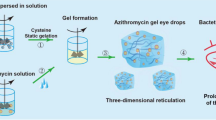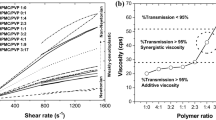Abstract
The objective of this study was to develop an ion-activated in situ gelling vehicle for ophthalmic delivery of matrine. The rheological properties of polymer solutions, including Gelrite, alginate, and Gelrite/alginate solution, were evaluated. In addition, the effect of formulation characteristics on in vitro release and in vivo precorneal drug kinetic of matrine was investigated. It was found that the optimum concentration of Gelrite solution for the in situ gel-forming delivery systems was 0.3% (w/w) and that for alginate solution was 1.4% (w/w). The mixture of 0.2% Gelrite and 0.6% alginate solutions showed a significant enhancement in gel strength at physiological condition. On the basis of the in vitro results, the Gelrite formulations of matrine-containing alginate released the drug most slowly. For each tested polymer solution, the concentration of matrine in the precorneal area was higher than that of matrine-containing simulated tear fluid (STF) almost at each time point (p < 0.05). The area under the curve of formulation 16 (0.2%Gelrite/0.6%alginate) was 4.65 times greater than that of containing matrine STF. Both the in vitro release and in vivo pharmacological studies indicated that the Gelrite/alginate solution had the better ability to retain drug than the Gelrite or alginate solutions alone. The tested formulation was found to be almost non-irritant in the ocular irritancy test. The overall results of this study revealed that the Gelrite/alginate mixture can be used as an in situ gelling vehicle to enhance ocular retention.









Similar content being viewed by others
References
Lee VHL, Robinson JR. Mechanistic and quantitative evaluation of precorneal pilocarpine disposition in albino rabbits. J Pharm Sci. 1979;68:673–84.
Higuchi WI. The analysis of data on the medicament release from ointments. J Pharm Sci. 1962;51:802–4.
McDonald MB, Protzko EE, Brunner LS, Morris TW, Haas W, Paterno MR et al. Efficacy and safety of besifloxacin ophthalmic suspension 0.6% compared with moxifloxacin ophthalmic solution 0.5% for treating bacterial conjunctivitis. Optometry. 2009;80:296–7.
Mundada AS, Shrikhande BK. Formulation and evaluation of ciprofloxacin hydrochloride soluble ocular drug insert. Curr Eye Res. 2008;33:469–75.
Sieg JW, Robinson JR. Vehicle effects on ocular drug bioavailability. I: Evaluation of fluorometholone. J Pharm Sci. 1975;64:931–6.
Nanjawade BK, Manvi FV, Manjappa AS. In situ-forming hydrogels for sustained ophthalmic drug delivery. J Contr Rel. 2007;122:119–34.
Ganguly S, Dash AK. A novel in situ gel for sustained drug delivery and targeting. Int J Pharm. 2004;276:83–92.
Miller SC, Donovan MD. Effect of Poloxamer 407 gel on the miotic activity of pilocarpine nitrate in rabbits. Int J Pharm. 1982;12:147–52.
Gurny R, Boye T, Ibrahim H. Ocular therapy with nanoparticulate systems for controlled drug delivery. J Contr Rel. 1985;2:353–61.
Rozier A, Mazuel C, Grove J, Plazonnet B. Gelrite®:a novel, ion-activated, in situ-gelling polymer for ophthalmic vehicles effect on bioavailability of timolol. Int J Pharm. 1989;57:163–8.
Lin HR, Sung KC. Carbopol/pluronic phase change solutions for ophthalmic drug delivery. J Contr Rel. 2000;69:379–88.
Hui HW, Robinson JR. Ocular delivery of progesterone using a bioadhesive polymer. Int J Pharm. 1985;26:203–13.
Sanzgiri YD, Maschi S, Crescenzi V, Calligaro L, Topp EM, Stella VJ. Gellan-based systems for ophthalmic sustained delivery of methyl prednisolone. J Contr Rel. 1993;26:195–201.
Meseguer G, Gurny R, Buri P, Rozier A, Plazonnet B. Gamma scintigraphic study of precorneal drainage and assessment of miotic response in rabbits of various ophthalmic formulations containing pilocarpine. Int J Pharm. 1993;95:229–34.
Carlfors J, Edsman K, Petersson R, Jornving K. Rheological evaluation of Gelrite in situ gels for ophthalmic use. Eur J Pharm Sci. 1998;6:113–9.
Cao YX, Zhang C, Shen WB, Cheng ZH, Yu LL, Ping Q. Poly(N-isopropylacrylamide)-chitosan as thermosensitive in situ gel-forming system for ocular drug delivery. J Contr Rel. 2007;120:186–94.
Miyazaki S, Suzuki S, Kawasaki N, Endo K, Takahashi A, Attwood D. In situ gelling xyloglucan formulations for sustained release ocular delivery of pilocarpine hydrochloride. Int J Pharm. 2001;229:29–36.
Agnihotri SA, Jawalkar SS, Aminabhavi TM. Controlled release of cephalexin through gellan gum beads: effect of formulation parameters on entrapment efficiency, size, and drug release. Eur J Pharm Biopharm. 2006;63:249–61.
Balasubramaniam J, Kant S, Pandit JK. In vitro and in vivo evaluation of the Gelrite gellan gum-based ocular delivery system for indomethacin. Acta Pharm. 2003;53:251–61.
Balakrishnana BJ, Mohantyb M, Umashankar PR, Jayakrishnana A. Evaluation of an in situ forming hydrogel wound dressing based on oxidized alginate and gelatin. Biomaterials. 2005;26:6335–42.
Liu Z, Li J, Nie S, Liu H, Ding P, Pan W. Study of an alginate/HPMC-based in situ gelling ophthalmic delivery system for gatifloxacin. Int J Pharm. 2006;315:12–7.
Joshi A, Ding S, Himmelstein. Reversible gelation compositions and methods of use. US Patent 5,252,318, 12 Oct 1993
Lin HR, Sung KC, Vong WJ. In situ gelling of alginate/pluronic solutions for ophthalmic delivery of pilocarpine. Biomacromolecules. 2004;5:2358–65.
Pongjanyakul T, Puttipipatkhachorn S. Xanthan–alginate composite gel beads: molecular interaction and in vitro characterization. Int J Pharm. 2007;331:61–71.
Wu CJ, Qi HY, Chen W, Huang C, Su C, Li W et al. Preparation and evaluation of a Carbopol/HPMC-based in situ gelling ophthalmic system for puerarin. Yakugaku Zasshi. 2007;127:183–91.
Yang HF, Zhang F. Research progress of matrine and its preparations. Qilu Pharm Affairs. 2008;27:551–3.
Chuang CY, Xiao JG, Chiou GCY. Ocular anti-inflammatory actions of matrine. J Ocul Pharmacol. 1987;3:129–34.
Li XT. The pharmacodynamics study of matrine gutta to cure bacterial keratitis and bacterial conjunctivitis. Master thesis, Jilin University; 2008. p. 19–30.
Hou ZH, Tan DM, Xie YT, Lu MH, Xie JP, Liu GZ et al. Therapeutic effect of matrine in patients with chronic hepatitis B. Pract Prev Med. 2005;12:824–6.
Liu JJ. Effect of matrine on the treatment of patient with chronic hepatitis B. China Med Abstr. 2006;27:43–5.
Cohen S, Lobel E, Trevgoda A, Peled Y. A novel in situ forming ophthalmic drug delivery system from alginates undergoing gelation in the eye. J Contr Rel. 1997;44:201–8.
Paulsson M, Hägerström H, Edsman K. Rheological studies of the gelation of deacetylated gellan gum (Gelrite) in physiological conditions. Eur J Pharm Sci. 1999;9:99–105.
Srividya B, Cardoza RM, Amin PD. Sustained ophthalmic delivery of ofloxacin from a pH triggered in situ gelling system. J Contr Rel. 2001;73:205–11.
Edsmana K, Carlforsa J, Harju K. Rheological evaluation and ocular contact time of some carbomer gels for ophthalmic use. Int J Pharm. 1996;137:233–41.
Draize JH, Woodard G, Calvery HO. Methods for the study of irritation and toxicity of substances. J Pharmacol Exp Ther. 1944;82:377–90.
Colo GD, Zambito Y, Burgalassi S, Nardini I, Saettone MF. Effect of chitosan and of N-carboxymethylchitosan on intraocular penetration of topically applied ofloxacin. Int J Pharm. 2004;273:37–44.
Deasy PB, Quigley KJ. Rheological evaluation of deacetylated gellan gum (Gelrite) for pharmaceutical use. Int J Pharm. 1991;73:117–23.
Manjappa AS, Nanjwade BK, Manvi FV, Murthy RSR. Sustained ophthalmic in situ gel of ketorolac tromethamine rheology and in vivo studies. Drug Dev Res. 2009;70:417–24.
Jansson PE, Lindberg B, Sandford PA. Structural studies of gellan gum an extracellular polysaccharide elaborated by Pseudomonas elodea. Carbohydr Res. 1983;124:135–9.
Grasdalen H, Smidsroed O. Gelation of gellan gum. Carbohydr Polym. 1987;7:371–93.
Moritaka H, Kimura S, Fukuba H. Rheological properties of matrix-particle gellan gum gel: effects of calcium chloride on the matrix. Food Hydrocolloids. 2003;17:653–60.
Yuguchi Y, Urakawab H, Kajiwarab K. The effect of potassium salt on the structural characteristics of gellan gum gel. Food Hydrocolloids. 2002;16:191–5.
Larsen B, Smidsrod O, Painter TJ, Haug A. Calculation of the nearest-neighbour frequencies in fragments of alginate from the yields of free monomers after partial hydrolysis. Acta Chem. 1970;24:726–8.
Haug A, Larsen B, Smidsrod O. A study of the constitution of alginic acid by partial hydrolysis. Acta Chem. 1966;20:183–90.
Funami T, Fang Y, Noda S, Ishihara S, Nakauma M, Draget KI et al. Rheological properties of sodium alginate in an aqueous system during gelation in relation to supermolecular structures and Ca2+ binding. Food Hydrocolloids. 2009;23:1746–55.
Morris VJ, Tsiami A, Brownsey GJ. Work hardening effects in gellan gum gels. J Carbohydrate Chem. 1995;14:667–75.
Author information
Authors and Affiliations
Corresponding author
Rights and permissions
About this article
Cite this article
Liu, Y., Liu, J., Zhang, X. et al. In Situ Gelling Gelrite/Alginate Formulations as Vehicles for Ophthalmic Drug Delivery. AAPS PharmSciTech 11, 610–620 (2010). https://doi.org/10.1208/s12249-010-9413-0
Received:
Accepted:
Published:
Issue Date:
DOI: https://doi.org/10.1208/s12249-010-9413-0




